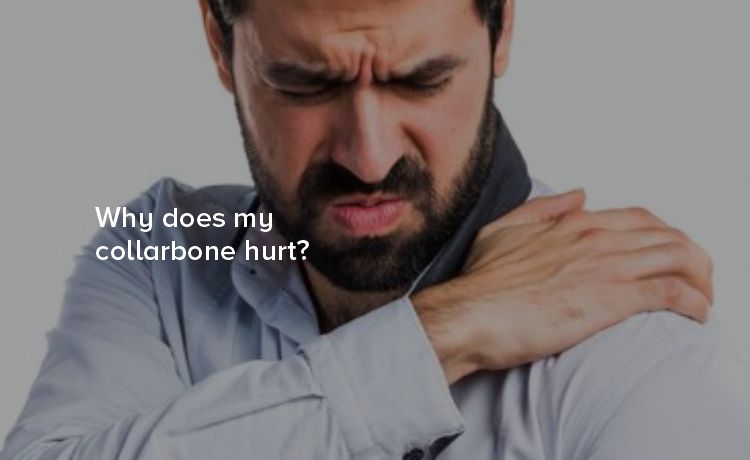
Collarbone pain can be a perplexing and frustrating experience for many. This crucial bone, which plays a vital role in arm movement and shoulder stability, can become a source of discomfort for various reasons.
The collarbone, or clavicle, is a long, slender bone that connects the sternum (breastbone) to the scapula (shoulder blade). It serves as a structural support for the shoulder and allows for a wide range of arm movements. Given its pivotal role, the collarbone is susceptible to injury and discomfort.
Fractures and Breaks
One of the most common reasons for collarbone pain is a fracture or break. This injury typically occurs due to a fall, sports accident, or car crash. Symptoms include severe pain, swelling, and difficulty moving the arm. If you suspect a fracture, seek medical attention immediately.
Shoulder Strain
Overuse or strain of the shoulder muscles can lead to collarbone pain. Activities that involve repetitive arm movements, such as swimming or lifting weights, can strain the muscles and ligaments around the clavicle, causing discomfort.
Arthritis
Arthritis, particularly osteoarthritis, can affect the joints around the collarbone. This degenerative condition leads to the breakdown of cartilage, causing pain, stiffness, and inflammation. Rheumatoid arthritis, an autoimmune disorder, can also impact the collarbone area.
Thoracic Outlet Syndrome
Thoracic Outlet Syndrome (TOS) occurs when blood vessels or nerves between the collarbone and first rib become compressed. This can cause pain in the collarbone, shoulder, and neck, along with numbness and tingling in the fingers.
Costochondritis
Costochondritis is the inflammation of the cartilage connecting the ribs to the sternum. While it primarily affects the chest, it can also cause pain that radiates to the collarbone area. This condition is often mistaken for heart-related pain but is generally less severe.
Sternoclavicular Joint Injury
The sternoclavicular joint, where the collarbone meets the sternum, can become injured due to trauma or dislocation. This can lead to localized pain and swelling that affects collarbone movement.
Medical History and Physical Examination
A thorough medical history and physical examination are essential for diagnosing the cause of collarbone pain. Your doctor will ask about your symptoms, any recent injuries, and your activity levels. A physical examination will help identify tender areas and assess your range of motion.
Imaging Tests
Imaging tests, such as X-rays, MRIs, and CT scans, can provide detailed views of the collarbone and surrounding structures. These tests help diagnose fractures, dislocations, and soft tissue injuries that may not be visible during a physical exam.
Blood Tests
In cases where arthritis or infection is suspected, blood tests can help confirm the diagnosis. These tests measure inflammation markers and other indicators of specific conditions.
Rest and Immobilization
For minor injuries, rest and immobilization are often the first steps in treatment. Using a sling or brace can help support the collarbone and allow it to heal. Avoid activities that exacerbate the pain until recovery is complete.
Physical Therapy
Physical therapy can be beneficial for collarbone pain caused by muscle strain or arthritis. A physical therapist will design a customized exercise program to strengthen the shoulder muscles, improve flexibility, and reduce pain.
Medications
Over-the-counter pain relievers, such as ibuprofen and acetaminophen, can help manage pain and inflammation. In more severe cases, your doctor may prescribe stronger medications or corticosteroid injections.
Severe Pain and Swelling
If you experience severe pain, swelling, or a visible deformity in the collarbone area, seek medical attention immediately. These symptoms may indicate a fracture or dislocation that requires prompt treatment.
Persistent or Worsening Symptoms
Collarbone pain that persists or worsens over time should not be ignored. Chronic pain may signal an underlying condition that needs medical evaluation and treatment.
Numbness and Tingling
Numbness, tingling, or weakness in the arm or hand are concerning symptoms that may indicate nerve compression or other serious issues. Consult a healthcare professional if you experience these symptoms.
Proper Technique and Equipment
Using proper technique and equipment during physical activities can help prevent collarbone injuries. Ensure that your sports gear fits correctly and follow safety guidelines to reduce the risk of accidents.
Strengthening Exercises
Regular exercises to strengthen the shoulder and neck muscles can improve stability and reduce the likelihood of strain. Focus on exercises that target the rotator cuff, trapezius, and pectoral muscles.
Ergonomic Adjustments
Making ergonomic adjustments to your workspace can also help prevent collarbone pain. Ensure that your desk, chair, and computer setup promote good posture and reduce strain on the shoulders and neck.
Coping Strategies
Living with chronic collarbone pain can be challenging, but several coping strategies can help. These include practicing relaxation techniques, engaging in low-impact exercises, and using heat or cold therapy to manage pain.
Regular Check-Ups
Regular check-ups with your healthcare provider are essential for managing chronic pain. Your doctor can monitor your condition, adjust your treatment plan, and provide guidance on living with pain.
Collarbone pain can stem from various causes, ranging from minor strains to significant injuries. Understanding the potential sources of pain and seeking appropriate treatment are crucial steps toward relief. By taking preventive measures and staying informed about your condition, you can manage collarbone pain effectively and maintain a high quality of life. Contact with Top Orthopedics Hospital in Hyderabad.
Dr M. Suneetha is one of the top medical oncologists in Gurugram. He has a vast experience of more than 30 years in the field of Medical oncology. He his specialised in treating leukemia,lymphoma, hematological oncology and other complex oncology cases . He is also specialised in Bone Marrow Transplantation (BMT) treatment. He is working as a Senior Consultant, HOD, Medical Oncologist in American Oncology Institute, Gurugram.